1. Features, retail package
Inno3D introduces its first graphics card based on Nvidia's Fermi architecture, the GTX 470 Hawk. The GTX 470 has 448 SPs and a 320-bit memory interface. It was redesigned from the ground up to deliver the best performance on DX11 - adding dedicated engines in the GPU to accelerate key features like tessellation. The card promises to offer a great game performance and image quality, enabling film-like geometric realism for game characters and objects. Geometric realism is central to the GTX470 architectural enhancements for graphics. In addition, PhysX simulations are much faster, and developers can utilize GPU computing features in games most effectively. The combined power of DirectX 11, CUDA, and NVIDIA PhysX technologies are provided to offer cinematic visuals on your favorite games.
Basic specifications:
- CUDA cores 448
- Graphics Clock (MHz) 607
- Processor Clock (MHz) 1215MHz
- Memory Clock (MHz) 1674MHz
- Memory Amount 1280MHZ
- Memory Interface 320 bit
- Memory Bandwidth (GB/sec) 133.9
- Texture Fill Rate (billion/sec) 34
Besides the general features and advantages of the GTX 470 chip, Inno3D's Hawk card is offering more due to its special cooling system. The improved Inno3D GTX 470 Hawk is equipped with two 80mm PWM fans with a 90mm PWM fan between them that run from 900 to 2,000 RPM. Together with five heatpipes and 3x PWM fans, GTX 470 Hawk achieves a thermal resistance of 0.36°C/Watt. This cooling performance is expected to bring enthusiasts a great overclocking experience:

Despite boasting three enormous PWM fans, the GTX 470 Hawk manages to keep the noise level extremely low. Controlled by the PWM signal, the fans at the necessary speed in order to offer sufficient cooling at the lowest possible noise level. Even at full fan speed, the GTX 470 Hawk generates only 18-29dBA, a much quieter performance than the standard cooler and other aftermarket coolers:


The above chart illustrates the cooling performance of two Inno3D GeForce GTX 470’s - one is equipped with the reference cooler and the other one has the triple fanned Hawk on board. Both cards were tested under the same platforms enduring full load testing . Clearly the Hawk cooler performed 24% better than the reference cooler with the reference showing signs of stress at 92°C.
- Retail package
The Inno3D GTX470 Hawk retails in a medium-sized box with a futuristic design and several sticker/ logos on it. At the time this article was written, we didn't find the product listed online. However, the generic Inno3D GTX470 costs a ~€360 (including VAT) so we assume the GTX 470 Hawk will cost you some extra bucks. This is almost what you need in order to get a competing graphics solution, the ATI HD5870 series.


The package includes the graphics card, an iChiLL gaming mouse pad , a DVI-D to DSub15 converter and a power cable in case your power supply doesn't have 2 PCI-e power cables. There are also two discs with drivers and applications that you may need to have a look.

Let's have a closer look to the card. The Inno3D GTX 470 Hawk is huge, equipped with a unique cooling system (made by Artic Cooling). The board of the card is 25cm long but its reaches the 27cm with the cooling system installed, so make sure this 'monster' fits in your PC case :)

As we mentioned earlier, the card is equipped with two 80mm PWM fans and a 90mm PWM fan placed between them. The fans are spinning at 900 to 2,000 RPM to cool down the heatsinks and your GPU, as a five heatpipes conduct the heat from the GPU:




The card should be powered by a 550 Watt power supply unit or higher and two PCI-e power cables. Due to the size of the cooling system, the card takes up three slots once installed.
Below you can see the dual DVI and the HDMI port of the card:

As the CPU-Z utility confirms, the Inno3D GTX 470 Hawk GPU core runs
at 608MHz, with the shader clocked at 1215MHz and the memory clock set at 837MHz. These are the stock speeds for the Nvidia GTX470 card but we hope that the improved cooling system of the Hawk model will offers some space for overclocking:

2. Test PC, software
- Setup
All the test were conducted using the following PC setup:
- Motherboard: Asus Stiker II Extreme Bios 1403 (Nvidia 790i Ultra SLI)
- Processor: Intel Q9300 (Quad Core @ 2.50GHz)
- Case: Open Air testbed
- Power Supply: OCZ GameXStream GXS600 SLI-Ready
- Memory: 2x1GB Supertalent DDR3-1600 (1333MHz@ 7-7-7-20-1T)
- HDD: Seagate 7200.12 500GB SATA2 7200RPM
- Monitor: LG L246WH-BH 24"
- Windows VISTA SP2 32bit with all the latest updates installed
- DirectX August 2009
- Nvidia Drivers 197.75 (beta) with High Quality settings
Many games and applications were used for the evaluation of the performance of each graphics card. In addition we used the FRAPS software to measure the in-game performance when needed.
DirectX 9
- 3DMark 05 v1.3.0
- 3DMark 06 v1.1.0
- Half Life 2: Episode 2
- Crysis v1.2.0 Retail
- Crysis WarHead v1.00 Retail
- Far Cry 2 v1.02 retail
DirectX10
- 3DMark Vantage v1.0.1
- Company Of Heroes v1.7.1
- Crysis v1.2.1 Retail
- Crysis WarHead v1.00 retail
- Far Cry 2 v1.00 retail
- Left4Dead v1.00 retail
- Urinue Benchmark v1.00
- StreetFighter IV Benchmark v1.00
- Stalker: Call Of The Pripyat v1.00
- Dirt2 v1.00 retail
3. Testbed DirectX9, DirectX10
- Testbed DirectX9
For all the tests we used the default settings of the 3DMark05 software as you can see below:

Again we left all the settings to default:

- Testbed DirectX10
We used the three built- in benchmarks to test the performance of each graphics card. We measured the performances at various resolutions using the "Performance" and up to the "Extreme" settings.
- Company Of Heroes (v1.7.1)

We used the built-in benchmark with all the graphics detail settings maxed out.

We used the hocbench Crysis benchmark tool at the resolutions of 1280x1024, 1680x1050 and finally 1920x1200. We run the benchmark software with "High" and "Very High" details enabled in order to identify the optimum settings for a decent game play.

We used the FRAMEBuffer benchmark tool at 1280x1024, 1680x1050 and finally at 1920x1200. All the possible quality levels were set in order to get an idea of what each graphics card can offer.
We used the built-in benchmarking utility and maxed out all visual details, under both DX9/DX10 and settings up to 16x AA/16x AF.

4. Benchmarks - FutureMark Hall Of Fame
Futuremark's 3DMark 05, 3DMark 06 3DMark Vantage benchmarks will provide us with the first performance numbers.
Starting with the 3DMark 05, the Inno3D GTX470 Hawk graphics card gave a very high score (16705 points) but still, it remains far away from the top as you can see in the table below:

In the 3DMark 06 benchmark, the Inno3D GTX 470 Hawk got the third place, this time outperforming the ATI-based Gainward HD4870 1GB GS:

The Inno3D GTX 470 Hawk finally showed its teeth in the latest 3DMark Vantage benchmark. The card's score was high enough to rank the card in the first place among all the cards we have tested in our labs. The only graphics card that reached the Hawk's performance was the Gainward Rampage 700 2GB GS, under the demanding ' Extreme' profile (1920 x 1200):

5. Benchmarks - Crysis Warhead, S.T.A.L.K.E.R: Call Of Pripyat Benchmark
- Crysis Warhead (DirectX9, DirectX10)
We start our in-game tests with some measurements with the "Crysis Warhead" game title. Compared to the original "Crysis" title, the new game features many visual improvements under both the DirectX9 and the DirectX10 rendering modes.
Below you can read the results (F.P.S.) we got in resolutions up to 1920 x 1200 with the anti-aliasing (AA) function disabled. The Inno3D GTX 470 Hawk delivers a great performance even at the demanding 'Enthusiast' level. However, an SLI configuration would help you avoid the 17 ~ 18 FPS reported at as the lowest performance at 1920 x 1200 (Enthusiast mode, DirecX9, DirecX10):

But where does the Inno3D GTX 470 Hawk stand in the competition? Well, it seems that Inno3D's model is not the only one giving great results with Crysis Warhead (DirectX 9). As you can see in the charts below, the Inno3D GTX 470 Hawk does not make the difference and its performance can be easily compared with other graphics solutions, no matter the playing resolution you may choose:

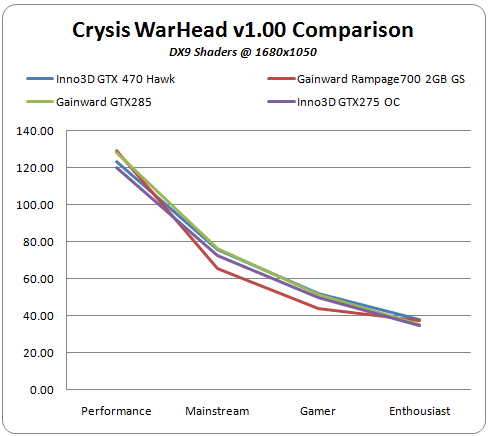

On the other hand, if you play the Crysis Warhead game under DX10 you may notice some extra power using the Inno3D GTX 470 Hawk. The card had a better performance from the rest graphics solutions of this test, especially especially at the higher resolutions and with the quality level set to the 'Enthusiast' mode. The GTX 470 series are generally optimized to work with DX11 games but they also performs equally well with DX10 titles:
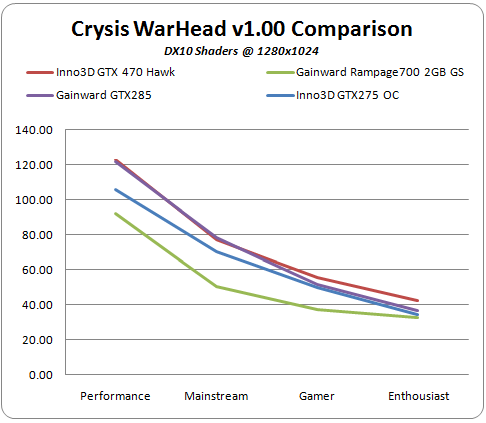


- S.T.A.L.K.E.R: Call Of Pripyat Benchmark
The "Call of Pripyat" benchmark is freely available for everyone in order to have an idea of the visuals of the upcoming game and also test your system with the game and share your score online with other users. For this test. we set the visuals at the 'Extreme' mode (highest detail) under DX10 and DX11and a resolution of 1920x1200.

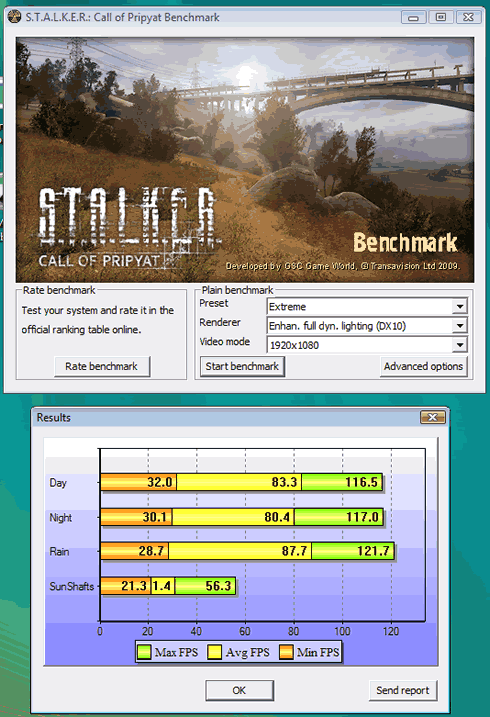
The results are very good for the Day/Night/Rain modes and remain adequate under the demanding 'SunShaft' mode.
Running the benchmark in the DirectX 11 mode didn't;t make things any harder for the Inno3D GTX 470 Hawk. The reported FPS remained as good as we experienced before under DirectX 10:

6. Benchmarks - Company Of Heroes v1.71 (DX 10)
Company Of Heroes is a popular action/strategy DirectX 10 game featuring impressive game physics. For this test, we set the visual details to the maximum and measured the performance of the Inno3D GTX470 Hawk graphics card using the game's built-in benchmark.
We couldn't expect anything more from the card as it easily took the first place as you can see in the below charts:



7. Benchmarks - Far Cry 2, Left4Dead, StreetFighter IV, Unigine Benchmark
- Far Cry 2 (DirectX 9/10)
The Far Cry 2 game can be played in both DirectX 9 and DirectX10 modes. Compared to the Crysis game we tested earlier today, the Far Cry is less demanding for the hardware.
We start the benchmarks in the DX 9 mode. As you can see in the charts below, the The Inno3D GTX 470 shows its strength under the "Ultra High" visual settings:



Enabling the DX10 shaders and the 'Ultra high' quality quality gives the Inno3D GTX 470 Hawk a significant performance advantage over other graphic cards:

- Left4Dead (DirectX 9)
The latest Source engine is found in the ' Left4Dead' game title. We used a custom time demo and measured the performance of the graphics card using the embedded console. The measurements started at 1280x1024 and up to 1920x1200 with 16xAF enabled all visual settings maxed out.
The Inno3D GTX 470 Hawk performed very well, although the GTX 285 gave slightly slight higher FPS in all the resolutions:
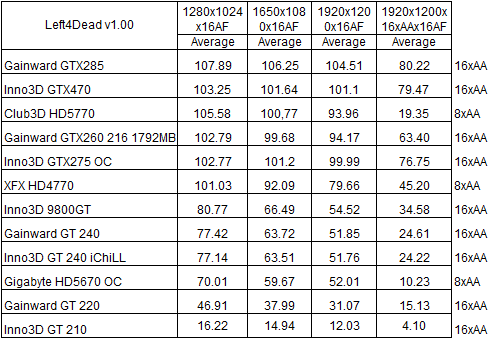
- StreetFighter IV (DirectX 9)
Below you can see the results of two more benchmarks, the Streetfighter IV (DX9) game and the Unigine Benchmark v1.0 (DX10). The Inno3D GTX 470 Hawk remains the fastest card in the test.

8. Dirt 2 (DX11) benchmark, Overclocking
- Dirt 2 (DX11)
Colin McRae: Dirt 2 (known as Dirt 2 outside Europe and stylised, DiRT) is a racing game released in September 2009, and is the sequel to Colin McRae: Dirt. The game runs on an updated version of the EGO engine, which powered Codemasters' Race Driver: Grid as well. The engine features an updated physics engine and runs on DirectX 11.

It is obvious that the Inno3D GTX470 Hawk game has been developed to offer a great gaming experience with DirectX11 games. As you can see in the table below, the card gave a superb performance even when we enabled AA with DX11 and a resolution of 1920x1200:

- Overclocking
In order to easily overclock Nvidia's new Fermi series, users need to download the MSI AfterBurner 1.60 beta 5 software utility. The utility also unlocks the card's voltages allowing users to experiment with the card's limits even more. MSI's AfterBurner software is very easy to understand and work with. The 'Core Voltage' slider can be adjusted to push the voltage up to 1.087V. The 'Core Clock' slider is not selectable until you set the 'Shader Clock' slider in the desired position first. Finally the 'Memory clock' slider can be can be adjusted as desired and the fan speed can be either set or left to the 'Auto' mode.
The MSI package also includes the 'MSI Kombustor' application that stresses your graphics card in order to test its stability under overclocking. The application can be used in order to have quick stability results:

We starting our overclocking experiments and quickly managed to get a stable 687MHz/1373MHz/1765MHz overclocking without messing with 'Core voltage' at all. Don't expect any significant performance gains from this tweaking so far:

The next step was to push the card to its limits by setting the 'Core Voltage' to 1.087V. This allowed us to get a stable 805MHz/1610MHz/1900MHz:
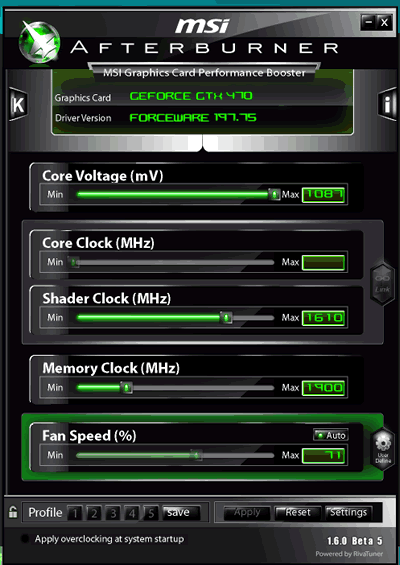
According to the GPU-Z utility, the reported temperatures were reasonable enough with the maximum temperature for the GPU to reach the 73 degrees Celsius. This should be attributed to the big cooling system installed to the Inno3D GTX470 Hawk card. At the same time, the noise level coming out from the three fans was lower than 44dB.

So can users expect from a 805MHz/1610MHz/1900MHz overclocking?
The 3D Mark Vantage gives you the first answer with the overclocked Inno3D GTX470 to score significantly higher than itself (running at factory speeds) and of course the rest of the graphics cards we have tested so far:

In real gaming, overclocking gave us some extra 10 FPS when we ran Far Cry 2 at 1920x1200 with 8xAA and 'Ultra quality' - an impressive gain. You can further experiment with MSI's overclocking utility in order to achieve the overclocking that better fit your gaming needs. Here are some achievable overclocking scenarios, according to our tests:
- GTX 470 @ 600/1215/1674
- GTX 470 @ 725/1450/1800 (1.025v)
- GTX 470 @ 750/1500/1800 (1.050v)
- GTX 470 @ 750/1500/1875 (1.050v)
- GTX 470 @ 788/1575/1900 (1.062v)
9. Final words
The Inno3D GTX 470 Hawk is the first graphics card we tested based on Nvidia's Fermi chips. We are generally very satisfied with the card's performance/price ratio. The Fermi series are very strong at when it comes to demanding gaming at resolutions of 1920x1200+ , something that was confirmed by our tests. The Inno3D GTX 470 Hawk was very strong at high resolutions and demanding visual settings but in some cases, previous generation cards were "faster" in lower resolutions such as the 1280x1024. As a result, if you are planning to get such a high-end graphics card and your monitor's is at the 17"~19" range, you'd better check for another and graphics solution, which will also cost you less.
The Inno3D GTX 470 Hawk is huge in size, it consumes much power and as such, it has to be equipped with a more efficient cooling solution than Nvidia's stock one. That's why Inno3D has introduced its own cooling system for its Fermi series of graphics cards - with a great success according to our tests. The temperature of the GPU was just 73 degrees C Celsius under full overclocking, while Nvidia's stock cooling system kept the temperature at around 90 C.
Performancewise, the Inno3D GTX 470 Hawk is very fast and will make you feel confident when you fire up your favorite game even at full-HD resolutions and demanding visual settings.
The Inno3D GTX 470 Hawk is a very attractive solution for overclocking enthusiasts users who wish to buy a reasonably priced GTX 470 - based graphics. At the same price range, the competition is offering the ATI HD5870 series. It's probably another interesting option but since we haven't tested it we cannot be sure of what you can expect. Nevertheless, the Inno3D GTX 470 Hawk is a superb solution for power users offering with a great performance, high overclocking margins and it is available at a reasonable price for the category.

